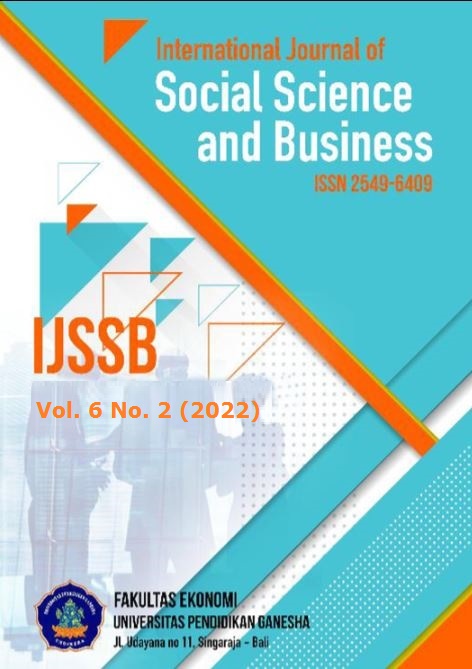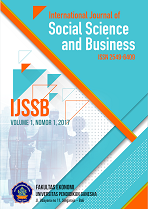Domestic Tourists' Revisit Intention: The Role of Novelty and Destination Image at Hidden Canyon Beji Guwang
DOI:
https://doi.org/10.23887/ijssb.v6i2.46014Keywords:
Domestic tourist, destinations, Hidden Canyon, Beji GuwangAbstract
The uniqueness of natural tourism and new tourist experiences at Hidden Canyon Beji Guwang can attract tourists to visit this destination. The novelty aspect of the destination allows new experiences for tourists to stimulate their beliefs about the destination and influence the decision-making process. In addition, the destination's image is an essential factor that influences the intention of returning tourists. This study aims to analyze the effect of novelty and destination image on the intention to revisit domestic tourists at Hidden Canyon Beji Guwang. This research uses quantitative methods. Data from the online questionnaire survey was collected from 100 domestic tourists who had visited Hidden Canyon Beji Guwang from 2018 to 2021. The data analysis technique used was multiple regression analysis. Data were analyzed using SPSS Version 25.0. The test results show that the novelty of Hidden Canyon Beji Guwang partially has a positive and significant effect on the intention to revisit domestic tourists. The destination's image has a positive and significant effect on the intention to revisit domestic tourists at Hidden Canyon Beji Guwang. The novelty and the destination's image simultaneously have a positive and significant effect on the intention to revisit domestic tourists at Hidden Canyon Beji Guwang.
References
Abbasi, G. A., Kumaravelu, J., Goh, Y.-N., & Dara Singh, K. S. (2021). Understanding The Intention to Revisit A Destination by Expanding The Theory of Planned Behaviour (TPB). Spanish Journal of Marketing - ESIC, 25(2), 282–311. https://doi.org/10.1108/SJME-12-2019-0109. DOI: https://doi.org/10.1108/SJME-12-2019-0109
Ahmadova, E. (2018). The Common/Unique and Cognitive/Conative Model Of Destination Image: The Case of Azerbaijan. Süleyman Demirel Üniversitesi İktisadi ve İdari Bilimler Fakültesi Dergisi, 23(1), 333–346. https://dergipark.org.tr/en/pub/sduiibfd/issue/52998/703221.
Albaity, M., & Melhem, S. B. (2017). Novelty Seeking, Image, and Loyalty—The Mediating Role of Satisfaction and Moderating Role of Length of Stay: International Tourists’ Perspective. Tourism Management Perspectives, 23, 30–37. https://doi.org/10.1016/j.tmp.2017.04.001. DOI: https://doi.org/10.1016/j.tmp.2017.04.001
Alcocer, N. H., & Ruiz, V. R. L. (2020). The role of destination image in tourist satisfaction: the case of a heritage site. Economic Research-Ekonomska Istraživanja, 33(1), 2444–2461. https://doi.org/10.1080/1331677X.2019.1654399. DOI: https://doi.org/10.1080/1331677X.2019.1654399
Batat, W., & Phou, S. (2017). From Tourism Destination to Mundane Consumption of Place: An Asian Introspection of France. In Consumer Behavior in Tourism and Hospitality Research (Vol. 13, pp. 27–37). Emerald Publishing Limited. https://doi.org/10.1108/S1871-317320170000013002. DOI: https://doi.org/10.1108/S1871-317320170000013002
Bayih, B. E., & Singh, A. (2020). Modeling domestic tourism: motivations, satisfaction and tourist behavioral intentions. Heliyon, 6(9), e04839. https://doi.org/10.1016/j.heliyon.2020.e04839. DOI: https://doi.org/10.1016/j.heliyon.2020.e04839
Blomstervik, I. H., Prebensen, N. K., Campos, A. C., & Pinto, P. (2021). Novelty in Tourism Experiences: The Influence of Physical staging and Human Interaction on Behavioural Intentions. Current Issues in Tourism, 24(20), 2921–2938. https://doi.org/10.1080/13683500.2020.1854197. DOI: https://doi.org/10.1080/13683500.2020.1854197
Chang, C.-H., Shu, S., & King, B. (2014). Novelty in Theme Park Physical Surroundings: An Application of the Stimulus–Organism–Response Paradigm. Asia Pacific Journal of Tourism Research, 19(6), 680–699. https://doi.org/10.1080/10941665.2013.779589. DOI: https://doi.org/10.1080/10941665.2013.779589
Chaulagain, S., Wiitala, J., & Fu, X. (2019). The Impact of Country Image and Destination Image on US Tourists’ Travel Intention. Journal of Destination Marketing & Management, 12, 1–11. https://doi.org/10.1016/j.jdmm.2019.01.005. DOI: https://doi.org/10.1016/j.jdmm.2019.01.005
Junaedi, S., & Harjanto, J. (2020). Examining the Effect of Destination Awareness, Destination Image, Tourist Motivation, and Word of Mouth on Tourists’ Intention to Revisit. In W. A. Barnett & B. S. Sergi (Eds.), Advanced Issues in the Economics of Emerging Markets (Vol. 27, pp. 27–38). Emerald Publishing Limited. https://doi.org/10.1108/S1571-038620200000027003. DOI: https://doi.org/10.1108/S1571-038620200000027003
Khan, M. J., Chelliah, S., & Ahmed, S. (2017). Factors influencing destination image and visit intention among young women travellers: role of travel motivation, perceived risks, and travel constraints. Asia Pacific Journal of Tourism Research, 22(11), 1139–1155. https://doi.org/10.1080/10941665.2017.1374985. DOI: https://doi.org/10.1080/10941665.2017.1374985
Kitouna, S., & Kim, Y.-G. (2017). Tourists’ Novelty-Seeking Motivation in Nature-Based Tourism Destinations: The Case of Vang Vieng City in Laos. International Journal of Tourism and Hospitality Research, 31(10), 45–58. https://www.dbpia.co.kr/pdf/pdfView?nodeId=NODE07269964. DOI: https://doi.org/10.21298/IJTHR.2017.10.31.10.45
Mannan, M., Chowdhury, N., Sarker, P., & Amir, R. (2019). Modeling Customer Satisfaction and Revisit Intention in Bangladeshi Dining Restaurants. Journal of Modelling in Management, 14(4), 922–947. https://doi.org/10.1108/JM2-12-2017-0135. DOI: https://doi.org/10.1108/JM2-12-2017-0135
Manurung, H. H., & Astini, R. (2020). The Influence of Destination Awareness, Destination Image and Destination Experience on Travel Decision to Baduy Cultural Tourist Destination, Banten. Saudi Journal of Business and Management Studies. https://doi.org/10.36348/sjbms.2020.v05i10.002. DOI: https://doi.org/10.36348/sjbms.2020.v05i10.002
Marques, C., Vinhas da Silva, R., & Antova, S. (2021). Image, satisfaction, destination and product post-visit behaviours: How do they relate in emerging destinations? Tourism Management, 85(January), 104293. https://doi.org/10.1016/j.tourman.2021.104293. DOI: https://doi.org/10.1016/j.tourman.2021.104293
Mitas, O., & Bastiaansen, M. (2018). Novelty: A mechanism of Tourists’ Enjoyment. Annals of Tourism Research, 72, 98–108. https://doi.org/10.1016/j.annals.2018.07.002. DOI: https://doi.org/10.1016/j.annals.2018.07.002
Nguyen Viet, B., Dang, H. P., & Nguyen, H. H. (2020). Revisit Intention and Satisfaction: The role of Destination image, Perceived Risk, and Cultural Contact. Cogent Business & Management, 7(1), 1796249. https://doi.org/10.1080/23311975.2020.1796249. DOI: https://doi.org/10.1080/23311975.2020.1796249
Phau, I., Quintal, V., & Shanka, T. (2014). Examining A Consumption Values Theory Approach of Young Tourists Toward Destination Choice Intentions. International Journal of Culture, Tourism and Hospitality Research, 8(2), 125–139. https://doi.org/10.1108/IJCTHR-12-2012-0090. DOI: https://doi.org/10.1108/IJCTHR-12-2012-0090
Promsivapallop, P., & Kannaovakun, P. (2017). A Comparative Assessment of Destination Image, Travel Risk perceptions and travel Intention by Young Travellers Across Three ASEAN Countries: A Study of German Students. Asia Pacific Journal of Tourism Research, 22(6), 634–650. https://doi.org/10.1080/10941665.2017.1308391. DOI: https://doi.org/10.1080/10941665.2017.1308391
Pujiastuti, E. E. (2020). Novelty Seeking To Predict Behavior Intention in Rural Destination. Jurnal Bisnis Dan Manajemen, 7(2). https://doi.org/10.26905/jbm.v7i2.4067. DOI: https://doi.org/10.26905/jbm.v7i2.4067
Risti, F. E., & Anom, I. P. (2018). Potensi Hidden Canyon Beji Guwang Sebagai Daya Tarik Wisata Alam di Desa Guwang Kecamatan Sukawati, Gianyar. Jurnal Destinasi Pariwisata, 2, 269-273%V 5. https://doi.org/10.24843/JDEPAR.2017.v05.i02.p13. DOI: https://doi.org/10.24843/JDEPAR.2017.v05.i02.p13
Santos, V., Ramos, P., Sousa, B., & Valeri, M. (2021). Towards a framework for the global wine tourism system. Journal of Organizational Change Management, 35(2), 348–360. https://doi.org/10.1108/JOCM-11-2020-0362. DOI: https://doi.org/10.1108/JOCM-11-2020-0362
Sugianta, A. D. S. P., & Sunarta, I. N. (2018). Dampak Pengembangan Hidden Canyon Beji Guwang Sebagai Destinasi Wisata Terhadap Perekonomian Masyarakat Lokal Di Desa Guwang Kecamatan Sukawati Gianyar. Jurnal Destinasi Pariwisata, 1, 100-109%V 6. https://doi.org/10.24843/JDEPAR.2018.v06.i01.p15. DOI: https://doi.org/10.24843/JDEPAR.2018.v06.i01.p15
Sugiyono. (2014). Metode Penelitian Pendidikan Pendekatan Kuantitatif, Kualitatif, dan R&D. Alfabeta.
Sung, B., Hartley, N., Vanman, E., & Phau, I. (2016). How can the word “NEW” evoke consumers’ experiences of novelty and interest? Journal of Retailing and Consumer Services, 31, 166–173. https://doi.org/10.1016/j.jretconser.2016.02.010. DOI: https://doi.org/10.1016/j.jretconser.2016.02.010
Yen, T. F. T., & Wang, M.-H. (2020). Wine Cultural Event As A Growing Phenomenon: Role of Novelty, Value and Satisfaction in Developing WOM. Asian Journal of Education and Social Studies, 10(2), 29–41. https://doi.org/10.9734/ajess/2020/v10i230264. DOI: https://doi.org/10.9734/ajess/2020/v10i230264
Zhang, Y., Li, J., Liu, C.-H., Shen, Y., & Li, G. (2021). The Effect of Novelty on Travel Intention: The Mediating Effect of Brand Equity and Travel Motivation. Management Decision, 59(6), 1271–1290. https://doi.org/10.1108/MD-09-2018-1055. DOI: https://doi.org/10.1108/MD-09-2018-1055
Downloads
Published
How to Cite
Issue
Section
License
Copyright (c) 2022 Putu Gde Arie Yudhistira, Ni Kadek Reinita Andriyani, I Gede Agus Sukertha Yasa

This work is licensed under a Creative Commons Attribution-ShareAlike 4.0 International License.











